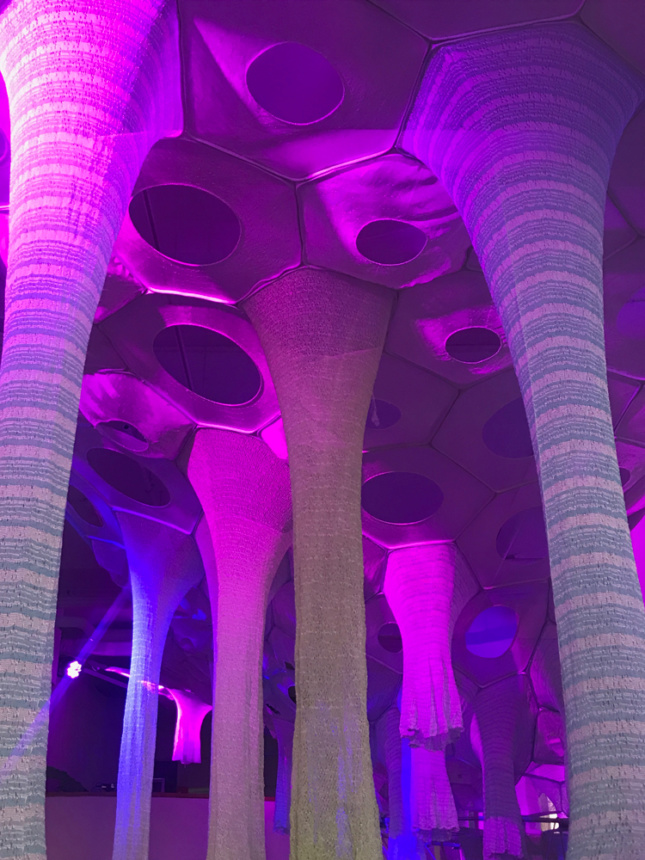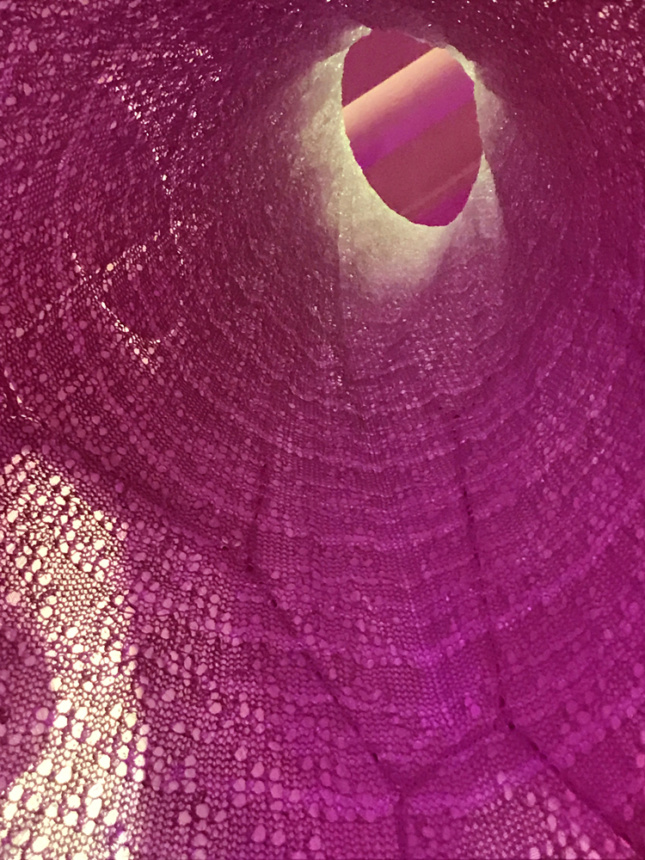Nature as a model for architectural forms has been mimicked as imagery since the first archetypal building, and now, natural biological systems are reaching a heightened interest in emerging fields of architecture, science, and material structures as biomimicry. In Metamorphosis of Plants, Goethe’s scientific understanding of “dynamic archetypes” focused on transformation and evolution rather than fixed forms and species – notions undeniably reimagined in the adaptive system of variant cellular structures and surfaces of Jenny Sabin Studio’s LUSTER. Rather than imitating nature, scaling up data or images found in nature, a canopy structure is created through an understanding of morphology relationships between generative and computational design. Building on her previous collaborations with biologists, Sabin’s representation of nature, as in in Sir D’Arcy’s “On Growth and Form,” is recast using 3d seamless knitting developed with Wholegarment technology.

As an engaged visitor immersed from dusk to nightfall in Sabin’s knit structures at House of Peroni New York debut exhibition of LUSTER curated by Art Production Fund, variable instances of growth are staged, playing out in a luminous performance of surfaces, rising and falling, as if inverted stalagmites captured in-formation. Like Goethe’s “sensuous dynamic archetype,” Sabin’s co-evolutional structure and materiality is animated by an opening and closing cellular system, distressed and stretched into unique yet familiar shapes. The systematized fabric sprouts a second life with striation patterns coming alive in alternating light and color transformations, where, one by one, photoluminescent knit fiber links are activated to release light. Sabin’s sensory and material choreographies create haptic desire. They set up responsive behaviors between the naturally swaying textured archetype and the human body, finding semblance in Tropos, Ann Hamilton’s topography of irregular patterned variegated horse-hair fibers’, or more closely in habitus’s gigantic hung textiles twirling in perpetual motion to the sound of their own mechanism. Moving beyond the organic, Sabin’s ethereal fabric surfaces dislodge the static experience to engage the body as perceptual devices – a testimony to human curiosity, sensory indulgence, and bodily silhouettes.

Similar to spherulite formation in crystalline cell structures that start as circular forms and collide and transmute into morphing geometries due to different growth rates, Sabin’s geometric assembly of parts to whole appear as mutations of the circle. Each part, either growing slowly in the canopy above, or rapidly descending as a figure hovering above the ground. Moving away from masculine, formulaic, cartesian space that relies on mathematical principles, Sabin refers to more feminine, systemic, network assemblies that don’t follow a rigid order. The porous, soft, intimate nature of the knit engages the visitor’s desire to touch and peer into. Non-programmed openings generate organic distribution of holes, giving the cone’s structures a degree of autonomy. Sabin’s approach blurs the boundary between the objectivity of science and subjectivity of our perception. Originally an error in the calculation of density of holes, a tightly stitched ring around each individual hole produced “knots,” offering added rigidity to the overall forms and becoming a design parameter to eliminate unwanted sagging.

Soon to be transported to 3 distinct environments and contexts, perhaps LUSTER’s most transformative power aims beyond its luminous essence through its formally responsive capacity for site-specific conditions. Adjustable distribution tension in the nylon webbing that supports the stretchy knit surfaces, along with zipper seam joints in areas that anticipate alternate configurations, the adaptive nature is masterfully built into her piece – transforming as a whole through its parts. House of Peroni’s 1-day lifespan installations and local artist interventions curated by Art Production Fund, incite visitors to witness how this ephemeral canopy might yield reincarnations of itself as a responsive archetype. From New York’s West Village industrial building at the edge of the Hudson river, to a converted indoor/outdoor warehouse in Los Angeles, an exterior waterfront space in Miami, and historic property in Washington, perhaps this project’s greatest luster is achieved by remaining in flux, shifting our perception of light and space as if the knitting machine was compelled to stop at its own intrinsic interval of time, capturing the beauty of the unfinished work of nature.
Exhibition dates and collaborating artists: Nov. 8th.: Jeanette Getrost, Los Angeles; Nov. 14th: Michelle Weinberg, Miami; and Nov. 28th Lu Zhang, Washington.








